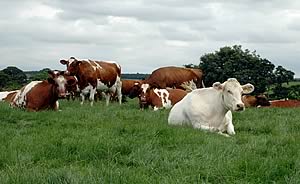 |
|||||||||
|
|||||||||||||||||||
|
|
Dairy Shorthorn Leads Both Sides of the Atlantic The Dairy Shorthorn is proving its superior characteristics of fertility and low somatic cell counts on both sides of the Atlantic.
In recently published annual National Milk Records figures, the Dairy Shorthorn among the top seven most numerous recorded breeds, has maintained its position with the lowest cell count at 178/ml as well as achieving the lowest calving interval at 399. Only the Dairy Shorthorn and the Island Jersey has missed once at maintaining its calving interval at under 400 in the last eight years. This superiority is also reflected in figures published earlier this year by the US Department of Agriculture (USDA) reveal that the American Milking Shorthorn is the most fertile breed in the US as well as tying with the Ayrshire for the lead in the lowest genetic cell counts. The Jersey came out next in the fertility rankings. Average milk yield for the breed recorded by NMR has declined from 6,140kg to 6,008kg however this reflects a trend across the other leading breeds - Holsteins, Jerseys, British Friesians and Island Jerseys - with the exception of Ayrshires and Guernseys, in the figures to the end of September 2008. However the Shorthorn is increasing its share of the NMR recorded herd from 0.7 to 0.8, a rise of 258 lactations on the year to 4,287 and at their highest since the year ending September 2002 when they were at 3,753 and they are climbing back to the level of a decade ago at 4,515. This represents an increasing share of the NMR lactations which have fallen from 946,343 10 years ago to 551,949 for the last year. The Holstein's dominance of the recorded lactations has dropped on the year from 91.7 per cent to 91.1 per cent. Across all breeds, cell counts and calving index continued to rise with the average cell count at 202,000/ml and the calving index 424. The Shorthorn Society secretary Frank Milnes said: "The latest NMR figures and the findings in the US confirm the Dairy Shorthorn's ability to produce excellent quality milk while maintaining high levels of fertility. "Other breed attributes are excellent mobility and longevity and, as the cattle are good converters of forage to milk, they are suitable for all types of production systems, particularly extended grazing and organic systems. "The increasing number of Shorthorn NMR recorded lactations against a shrinking national dairy herd is testament that milk producers are re-awakening to the attributes of this traditional breed." "AMSS has accomplished something that, truth be told when we set out, I was not sure we could accomplish," said AMSS secretary David Kendall. "The drive to improve the economic competitiveness of the American Milking Shorthorn, the AMMS had identified fertility and somatic cell count as distinct possibilities. "As a result extra emphasis was placed on those two traits as young sires were and are selected and two bulls which transmitted management traits very well were Meriville Plumchuck and Vinra Glen Frost. "The other advantage we have had is the relative size of the breed. We have been quickly and effectively able to disperse superior genetics for Daughter Pregnancy Rate and Somatic Cell Count across a large percentage of the breed due to our size."
|
||||||||||||||||||

|
|
||||||||||||||||||
| home | agri-services | pedigree
pen | news | dairy | beef | machinery property | organisations | site map |
|||||||||||||||||||
